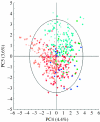Variation at range margins across multiple spatial scales: environmental temperature, population genetics and metabolomic phenotype
- PMID: 19324821
- PMCID: PMC2677219
- DOI: 10.1098/rspb.2008.1767
Variation at range margins across multiple spatial scales: environmental temperature, population genetics and metabolomic phenotype
Abstract
Range margins are spatially complex, with environmental, genetic and phenotypic variations occurring across a range of spatial scales. We examine variation in temperature, genes and metabolomic profiles within and between populations of the subalpine perennial plant Arabidopsis lyrata ssp. petraea from across its northwest European range. Our surveys cover a gradient of fragmentation from largely continuous populations in Iceland, through more fragmented Scandinavian populations, to increasingly widely scattered populations at the range margin in Scotland, Wales and Ireland. Temperature regimes vary substantially within some populations, but within-population variation represents a larger fraction of genetic and especially metabolomic variances. Both physical distance and temperature differences between sites are found to be associated with genetic profiles, but not metabolomic profiles, and no relationship was found between genetic and metabolomic population structures in any region. Genetic similarity between plants within populations is the highest in the fragmented populations at the range margin, but differentiation across space is the highest there as well, suggesting that regional patterns of genetic diversity may be scale dependent.
Figures



References
-
- Alleaume-Benharira M., Pen I.R., Ronce O. Geographical patterns of adaptation within a species' range: interactions between drift and gene flow. J. Evol. Biol. 2006;19:203–215. doi:10.1111/j.1420-9101.2005.00976.x - DOI - PubMed
-
- Angert A.L. Demography of central and marginal populations of monkeyflowers (Mimulus cardinalis and M. lewisii) Ecology. 2006;87:2014–2025. doi:10.1890/0012-9658(2006)87[2014:DOCAMP]2.0.CO;2 - DOI - PubMed
-
- Angert A.L., Bradshaw H.D., Schemske D.W. Using experimental evolution to investigate geographic range limits in monkeyflowers. Evolution. 2008;62:2660–2675. doi:10.1111/j.1558-5646.2008.00471.x - DOI - PubMed
-
- Antonovics J., McKane A.J., Newman T.J. Spatiotemporal dynamics in marginal populations. Am. Nat. 2006;167:16–27. doi:10.1086/498539 - DOI - PubMed
-
- Barton N.H. Adaptation at the edge of a species' range. In: Silvertown J., Antonovics J., editors. Integrating ecology and evolution in a spatial context. Blackwell; Oxford, UK: 2001. pp. 365–392.
Publication types
MeSH terms
LinkOut - more resources
Full Text Sources
